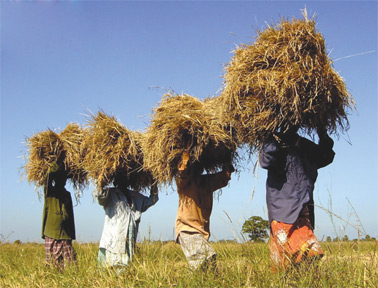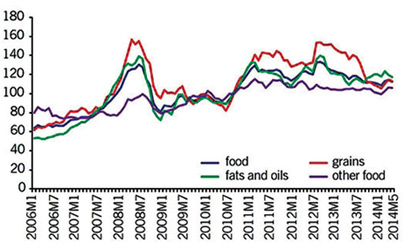Adverse weather affects food production worldwide
By Gamini Warushamana
As a result of adverse weather such as droughts, floods and cyclones,
another food crisis is looming globally. The latest edition of Food
Price Watch of the World Bank warned countries about the sharp increase
in food prices and possible political instability in the future.
"International food prices increased by four percent between January
and April 2014, interrupting sustained declining trends in food prices
observed since August 2012," the report said.
 S and P, GSCI agricultural and livestock index has jumped over 10
percent from January 2 to June 2 this year. The index recorded 1,053.83
in January and increased to 1,229.60 on May 1 and declined to 1,165.59
on June 2. S and P, GSCI agricultural and livestock index has jumped over 10
percent from January 2 to June 2 this year. The index recorded 1,053.83
in January and increased to 1,229.60 on May 1 and declined to 1,165.59
on June 2.
The increase is associated with the increase in prices of coffee,
cocoa, wheat and other grains since the beginning of the year and the
reasons pointed out are climate related, such as drought in Brazil and
in the grain growing regions of the US, Ukraine and Australia.
Sri Lanka too faces the same threat and there is a sharp price
increase in the main staple food, rice and vegetables produced locally.
Inevitably we will feel the increase in global food prices as we depend
on imports.
The adverse impact on paddy production is the main concern and
usually the largest harvest comes from the Maha season every year. In
the 2012-2013, the Maha season harvest was 2.8 million tonnes. The
harvest in the 2013 Yala season was 1.8 million tonnes.
The 2013-14 Maha season was hit by drought and the harvest was 2.4
million tonnes, a significant decline.
Sufficient irrigation water was not available for this year's Yala
season to cultivate paddy in the main rice growing areas of the dry zone
including the Mahaweli zones and farmers were advised to cultivate other
crops.
The only hope was the Yala season harvest from wet zone paddy lands
cultivated with water from the South West monsoon rains.
The Department of Census earlier estimated a paddy harvest of 1.2
million tonnes during the Yala season. But the delay in the monsoon and
unexpected heavy rains and floods destroyed most of the paddy
cultivations in the Southern, Western and Sabaragamuwa provinces.
Therefore, a shortage of rice is inevitable in the coming months.
Already rice prices have increased to maximum in recent years and the
average retail price of rice is above Rs.75.
Rice is the staple food of the majority of the people and this price
increase has a serious impact on them.
Annual per capita consumption of rice in Sri Lanka is estimated at
114 kg.
However, the farmer community who always suffer losses as a result of
the drop in paddy prices, gained this year due to the short supply and
resulting increase in farm gate paddy prices.
The price increase may boost cultivation in the coming years.
Abandoning paddy cultivation which is not commercially viable is a major
issue with regard to food security.
Even with government support of heavy fertiliser subsidy, the extent
of paddy cultivation drops every year.
Since there is always a dilemma over safeguarding the interests of
farmers and the consumers the rice price increase is still not a major
concern of the authorities and therefore, there is no rush to dump
imported rice.
However, imported rice is trickling into the market and according to
Customs statistics 28,804 tonnes of rice had been imported from January
to April this year.
According to the Department of Census and Statistics, stocks
available are sufficient till December this year and the Director
General of the Department, D.C.A. Gunawardena said that there is no
reason to panic.
The last world food crisis was reported in 2007 and in the first half
of 2008.
 The causes for the food price increase were drought mainly in
grain-producing countries and resulting supply constraints and high oil
prices. High oil prices push food production costs due to the increase
in fertiliser prices and other costs. The causes for the food price increase were drought mainly in
grain-producing countries and resulting supply constraints and high oil
prices. High oil prices push food production costs due to the increase
in fertiliser prices and other costs.
The use of grain for bio-fuel production and trade restrictions are
the other major causes for food price increases.
According to the Economic Survey report of the Asian Development
Bank, world food prices in 2007-08 had increased by 30 percent compared
to the previous year.
High volatility in cereals, meat and edible oil prices have been
reported. Specially the price increase of the two key staple food items,
rice and wheat, creates a significant impact on a vast majority of the
people around the world.
According to European Commission (EC) reports international prices of
rice and wheat doubled from 2005 -2008.
There is a pattern in price movement. The food crisis is no longer a
one-off scenario and comes once in several years. Food prices are now
volatile at a higher level and reaching crisis level is frequent.
In 2011 too, a significant upward trend in food prices was reported
but it did not prevail for long due to the stockpiling of food after the
2007-08 crisis.
According to Oxfam International, from 2012, prices of maize, wheat
and sugar have increased by over 70 percent.
Previous experience shows that the food crisis could create social
and political unrest in the developing and developed countries. In
developing countries people spend 50-80 percent of their income on food
and, therefore, the unprecedented increase in prices makes essential
food items unaffordable for them. |

